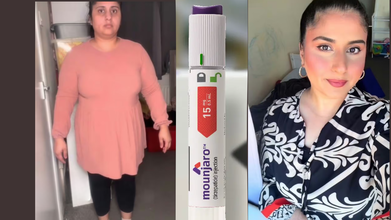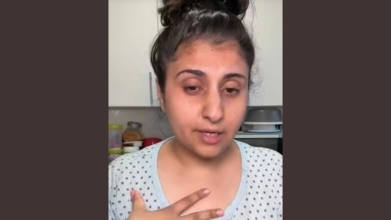- Health Conditions A-Z
- Health & Wellness
- Nutrition
- Fitness
- Health News
- Ayurveda
- Videos
- Medicine A-Z
- Parenting
- Web Stories
Google Doodle Honors Late Singer KK: Heart Health Tips to Protect Yourself

KK (Credit: Canva)
Google, on Friday, honoured Bollywood singer KK- Krishnakumar Kunnath with a vibrant doodle. The image featured the late singer holding a microphone and singing. KK passed away last year on May 31 at the age of 53. He died while performing at a concert in Kolkata on May 31. A later autopsy revealed cited myocardial infarction (heart attack) as the probable cause of death. Notably, he had previous heart conditions, including 80% blockage of his heart.
What Is A Heart Attack?
A heart attack occurs when blood flow to a part of the heart muscle is blocked, typically by a blood clot in a coronary artery. This blockage prevents oxygen-rich blood from reaching that part of the heart muscle, causing damage or eventual death of that muscle tissue.Common symptoms include chest pain or discomfort, shortness of breath, nausea, sweating, and pain in the arm, back, or jaw. Symptoms can vary and may be less obvious in some individuals.
Treatment for a heart attack often involves medications to dissolve the clot, restore blood flow, or prevent further clots, along with procedures like angioplasty or stenting. Lifestyle changes and cardiac rehabilitation are also recommended for recovery.
How Can You Prevent Heart Emergencies
Both heart attack and cardiac arrest can be caused due to Coronary or ischemic heart disease (CHD). Therefore, it is pivotal to maintain good heart health. Following are the precautionary tips you can use to prevent CHD, as per World Health Organization (WHO).Adopt a Heart-Healthy Diet: Focus on a diet rich in fruits, vegetables, whole grains, legumes, and nuts. Reduce intake of salty meats, processed foods, and sugary snacks. Opt for natural seasonings like calamansi juice and vinegar instead of high-sodium condiments, and drink water instead of sweetened beverages.
Manage Your Weight: Achieve and maintain a healthy weight by aiming for a BMI below 25 and reducing central obesity. Cutting 500 calories from your daily intake can help you lose about half to one kilogram per week.
Increase Physical Activity: Aim for at least 150 minutes of moderate exercise per week, such as brisk walking or gardening. Regular physical activity helps manage blood pressure, cholesterol, and weight.
Avoid Tobacco: Refrain from smoking and exposure to second-hand smoke. Quitting tobacco reduces your risk of heart disease significantly over time.
Limit Alcohol Consumption: Although occasional drinking is common, avoid alcohol entirely to minimize cardiovascular risk. There is no safe level of alcohol consumption for heart health.
Monitor Blood Pressure and Sugar Levels: Regularly check your blood pressure and blood sugar with a healthcare provider. Unchecked high blood pressure can damage your heart. If diagnosed with hypertension or diabetes, adhere to your treatment plan and involve your loved ones in your health journey.
Ebola Outbreak In Africa: 15 Dead, 28 Suspected Cases Raise Alarms

(Credit-Canva)
Health officials in the Democratic Republic of the Congo (DRC) have announced a new outbreak of the Ebola virus in Kasai Province. As of September 4, 2025, there have been 28 suspected cases and 15 deaths, including four health workers. The outbreak is affecting the Bulape and Mweka health zones.
The alarm was first raised when people in the area started showing a mix of worrying symptoms, including fever, vomiting, diarrhea, and bleeding. These symptoms are tell-tale signs of a serious illness. To find out what was causing it, officials took samples and sent them to a lab in Kinshasa, the country's capital. The lab results came back on September 3rd, confirming the cause was the Ebola Zaire virus.
What Is Ebola Virus?
According to World Health Organization (WHO), Ebola is a very serious and often deadly illness in people. It's caused by several different viruses, with the most common being the Ebola virus, which has led to large outbreaks. The chance of a person dying from Ebola is about 50%, but this number has varied widely in the past, from 25% to 90%.
To ensure safety, a team of experts from WHO, and the DRC's own rapid response unit has been sent to the area. Their main job is to quickly find sick people and get them care, stop the virus from spreading in hospitals, and teach local communities how to protect themselves.
The WHO is also sending a massive delivery of two tons of medical supplies, including protective gear for health workers and a special mobile lab. This is a big help, especially because the area is hard to get to, with few roads and limited air travel.
What is The First Symptoms of Ebola
The symptoms of Ebola usually start to appear 8 to 10 days after a person has been in contact with the virus, but it can take anywhere from 2 to 21 days. At first, the symptoms are similar to common illnesses and are often called "dry" symptoms:
- Fever
- Severe headache
- Aches and pains in muscles and joints
- Feeling very weak and tired
- Sore throat
Later Symptoms
As the illness gets worse, usually after four or five days, the symptoms change and become more severe. These are known as "wet" symptoms:
- Loss of appetite
- Unexplained bleeding
- Stomach-related problems like nausea, vomiting, abdominal pain, and diarrhea.
How Do You Treat and Control Ebola Virus?
While there's no guaranteed cure, getting early and strong medical care—like staying hydrated and treating symptoms—can greatly increase a person's chances of survival. Right now, approved vaccines and treatments are only available for the most common type of Ebola (Ebola virus), but scientists are working on others. To stop an outbreak from spreading, health officials use a mix of strategies:
- Taking care of the sick in a way that provides a lot of support.
- Preventing infection in hospitals and communities.
- Finding and tracking everyone who might have been in contact with an infected person.
- Quickly testing samples in labs.
- Ensuring safe burials for those who have died.
- Using vaccines when available.
- Educating the public on how to stay safe.
How Is The Ebola Outbreak In Kasai Being Dealt With?
The DRC is well-prepared to fight this outbreak. The country has a supply of treatments and 2,000 doses of the Ervebo Ebola vaccine. This vaccine is very effective against this specific type of Ebola. The doses, which were ready and waiting in Kinshasa, are now being sent to Kasai.
They will be used to protect people who were in contact with infected individuals and to vaccinate the doctors and nurses on the front lines. The country has a lot of experience fighting Ebola—this is its 16th outbreak since the virus was first found in 1976. That experience will be a huge advantage in bringing this new outbreak to an end.
Spend Hours Scrolling On Your Phone On The Toilet? You Are Leading Yourself This Painful Condition

(Credit-Canva)
The time we spend in the washroom is meant to be a private time, where we do things like hygiene and self-care. Some people even like spending more time in their bathrooms as it gives them privacy, leaving them to do whatever they want like scroll on their phones while finishing their business on the toilet. However, this harmless habit could be the reason you develop this painful condition.
We've all heard about the health problems that come with using smartphones, but here's a surprising one: a new study suggests that scrolling on your phone while on the toilet can lead to hemorrhoids.
Why Smartphones Are the Problem
It's tempting to use your phone to pass the time in the bathroom. The problem is, phones are designed to keep you scrolling forever—unlike an old magazine that you'd put down after a few minutes. That long, unsupported sitting time puts stress on your body.
A study published in the Plos One found that people who use their phones in the bathroom are almost 50% more likely to have hemorrhoids. It’s also just plain unsanitary. When you flush the toilet, tiny germs fly into the air and land on everything, including your phone.
Researchers surveyed 125 adults about their toilet habits and then checked for hemorrhoids during a routine medical exam. Here's what they discovered:
A common habit
66% of the people surveyed admitted to using their phones on the toilet, most often to read the news or scroll through social media.
More time spent
Those who used their phones spent much more time on the toilet. Over a third of them stayed for more than five minutes per visit, compared to only a small percentage of people who didn't use a phone.
Higher risk
The study found that people who used their smartphones on the toilet had a 46% increased risk of developing hemorrhoids. This was true even when researchers considered other factors like age, diet, and physical activity.
Hemorrhoids aren't usually dangerous, but they can be itchy, painful, and even bleed, leading many people to see a doctor. Over time, all that straining can also weaken the muscles in your pelvic floor, which could cause issues like constipation or even loss of bladder control.
How Does Scrolling On Phone Cause Hemorrhoids?
When you sit on an open toilet, your pelvic floor has no support. This puts extra pressure on the veins in your rectum, causing them to swell and become inflamed. The longer you sit there, the worse the problem gets. The symptoms you experience depend on the type of hemorrhoid you have.
External hemorrhoids can cause itching, pain (especially when sitting), and a tender lump near your anus. These symptoms often go away on their own within a few days
Internal hemorrhoids might cause bright red blood in your stool or on the toilet paper. They usually aren't painful unless they fall out of the anal opening, which can cause pain and discomfort.
- You can often treat mild hemorrhoids with simple changes at home.
- Add more fiber to your diet and drink plenty of fluids.
- Avoid straining and don't sit on the toilet for a long time.
- Use over-the-counter pain relievers or special creams and ointments to help with pain and itching.
- Taking a few warm baths a day can also help relieve discomfort.
How Can You Lower The Risk of Hemorrhoids?
To avoid these problems, experts recommend a simple rule: don't sit on the toilet for more than 5 minutes. A study showed that a lot of people who use their phones in the bathroom spend much longer than that. If you absolutely must bring your phone with you, set a timer to make sure you don't get stuck in a scrolling rabbit hole. If nothing happens in five minutes, just get up and try again later.
Woman Lost 4 Stone Weight On Mounjaro, But These Horrific Side Effects Ruined Her Life

Credits: TikTok/zayreeshh
Zari, a mother and social media influencer, hit the headlines after detailing her terrible ordeal with weight-loss injection Mounjaro. Having previously worn UK sizes 18 to 20, she was overjoyed to lose four stone in four months. However, what had started out as one of transformation soon went horribly wrong and turned into a series of medical crises and constant agony, leaving her "in and out" of hospitals.
In a real TikTok clip, Zari disclosed that she now has gastritis, a painful stomach lining inflammation, which she never had prior to taking the medication. "As much as I love Mounjaro, I can hands down say it has ruined a part of me," she captioned her clip, highlighting the long-term effect on her health regardless of weight loss.
Gastritis presents as abdominal cramps, nausea, vomiting, belching, and gas. With Zari, the symptoms were sudden and severe, prompting repeated visits to hospital and copious blood work. Physicians diagnosed her symptoms as inflammation of the stomach lining, possibly due to Mounjaro usage.
As stated by the NHS, gastritis can be caused by Helicobacter pylori bacterial infections, anti-inflammatory pain medication, excessive drinking of alcohol, and extreme stress levels. These are usual causes; however, drugs such as Mounjaro, which manipulate the gastrointestinal tract, can induce serious instances in some people.

Mounjaro, which was sanctioned for individuals with a BMI of more than 30 or for individuals with BMI greater than 27 accompanied by weight-related health problems, is revered for its efficacy in swift weight loss. Zari shed four stone within a space of four months—a great feat for anyone with obesity.
Yet the cost of rapid transformation can sometimes outweigh the benefits. Zari admitted, “I look trash because I’m tired from the pain the whole night—Mounjaro has given me gastritis, and that is a killer.” She highlighted how even simple day-to-day activities are impacted, with pain interfering with her ability to eat, sleep, and function normally, reports The Mirror.

The most frequent side effects of Mounjaro are gastrointestinal. What this patient has experienced, although not the most frequent result, is within the known risk profile of the drug.

Mounjaro side effects, as stated by the NHS, most commonly include nausea, diarrhea, constipation, and indigestion that tend to decrease with time. Yet more dangerous side effects are reported, such as low blood sugar, gallstones, and pancreatitis. Severe gastritis, although less common, fits these documented gastrointestinal complications.
The Risks of Uncontrolled Use of Weight Loss Medications
Though Mounjaro is licensed to certain medical standards, some have used the drug privately without prescription or medical necessity. The situation leaves many questioning unnecessary exposure to the potentially dangerous side effects.
Medical professionals warn that the use of weight-reducing medication without proper medical scrutiny tends to increase health risks. Dr Curtis stressed the need for consultation with medical experts prior to beginning such medication, particularly for people with no underlying obesity conditions.
For Zari, the experience is a cautionary tale about the emotional and physical costs of rapid weight loss. Despite achieving a body transformation she previously desired, the physical toll has overshadowed her accomplishments. “It’s been two months, I’ve been going in and out of hospitals, getting drips and everything,” she explained.
The case highlights a broader societal trend: the increasing demand for injectable weight-reduction treatments such as Mounjaro, driven by social media exposure and culture of instant transformation, at times without adequate awareness of risks.
A representative from Lilly UK spoke with The Mirror, saying, "Patient safety is the number one concern for Lilly, and we take very seriously any information related to patient safety. Regulatory authorities independently review the benefits and risks of each new medication very thoroughly. Patients are urged to speak with their physician about any potential side effects and to verify that they receive authentic Lilly medicine."
This statement reflects the industry’s awareness of side effects and underscores the necessity of medically supervised use of prescription weight-loss treatments.
What Patients Must Consider Before Taking Weight-Loss Injections?
Zari’s experience emphasizes several key considerations for anyone contemplating injectable weight-loss therapies:
Medical oversight is crucial: Drugs like Mounjaro are approved for specific BMI categories and comorbidities; off-label use increases risk.
Recognition of gastrointestinal side effects: Severe pain, gastritis, and nausea, although rare, are possible.
Monitoring and follow-up: Ongoing assessment by health professionals allows for early identification of complications.
Physical and mental well-being balance: The speed of weight loss may not be worth enduring chronic pain or decreased quality of life.
Is Social Media Adding To The Weight Loss Pressure?
Platforms like TikTok amplify the visibility of “miracle” weight-loss stories, often glossing over potential side effects. Zari’s transparent account offers a critical counter-narrative, highlighting the risks that might not be widely discussed, the emotional distress, hospital visits, and daily disruption that severe side effects can bring.
As more individuals turn to weight-loss injections, healthcare providers and patients alike must weigh short-term aesthetic gains against long-term health consequences. Zari’s story is a stark reminder that the pursuit of rapid weight loss can come with unforeseen and life-altering costs.
Zari’s journey from celebrating a four-stone reduction to grappling with chronic gastritis—illustrates the complexities of medically supervised weight loss. Mounjaro remains an effective tool for many, but her experience underscores the importance of understanding potential side effects, adhering to medical guidance, and prioritizing overall health above aesthetic goals.
© 2024 Bennett, Coleman & Company Limited

